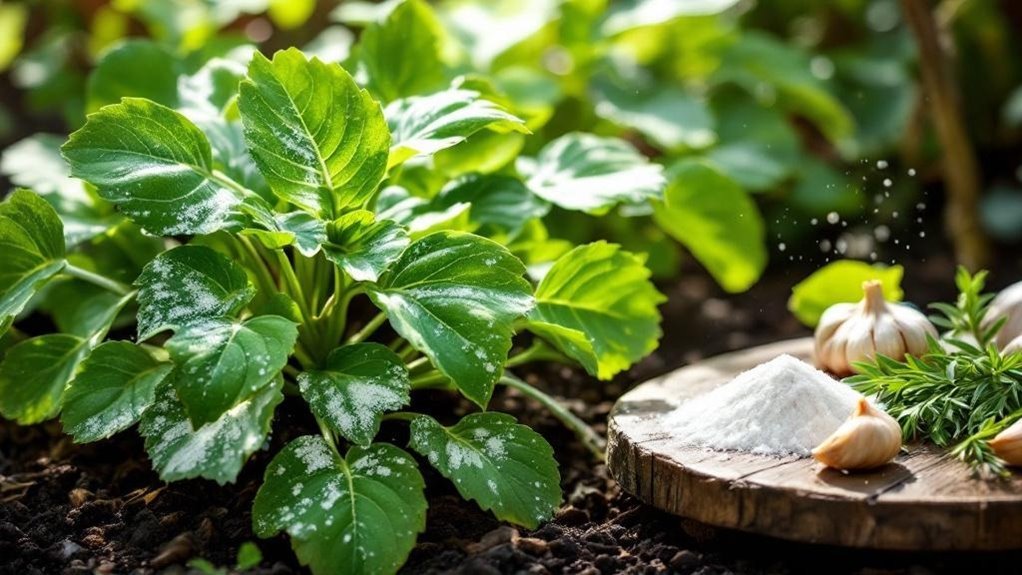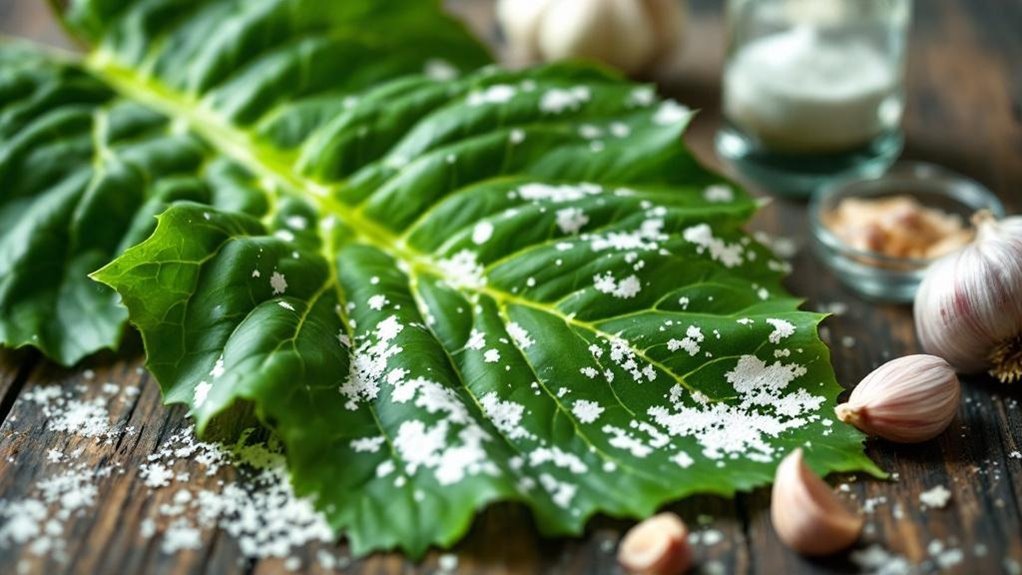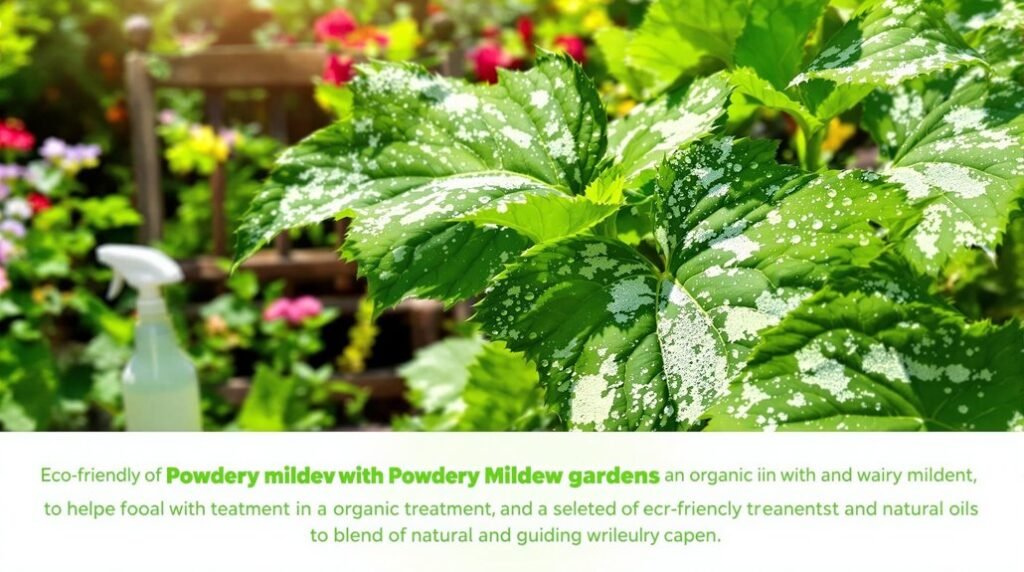If you’re dealing with powdery mildew, you know how stubborn it can be. You might hesitate to reach for harsh chemicals, especially if you want to keep your garden organic. Luckily, there are effective natural treatments that can help you manage this common fungal problem without compromising your plants’ health. Understanding these options could make all the difference in restoring your garden’s vigor. But what exactly makes these organic solutions work?
What Is Powdery Mildew?
Powdery mildew is a common fungal disease that shows up as white or gray powdery spots on your plants’ leaves, stems, and flowers.
Powdery mildew appears as white or gray powdery spots on leaves, stems, and flowers.
This fungal disease thrives in high humidity, especially at night, creating ideal conditions for its growth. You’ll notice these white powdery spots appearing on infected leaves first, signaling an existing infection.
Powdery mildew spreads easily through wind, insects, and water splashes, affecting various plants, including edible plants. The symptoms can reduce your plants’ vigor, causing leaves to wither, yellow, and drop prematurely.
While it rarely kills your plants, repeated infections weaken them. To manage powdery mildew effectively, you can use an organic fungicide, which helps control the fungal disease without harming your plants or the environment.
Acting early is key to protecting your garden.
Common Symptoms of Powdery Mildew
You’ll often spot a fine, white or gray dusting on your plants’ leaves, stems, or flowers when mildew attacks. These white spots are a primary symptom of powdery mildew and signal trouble for your garden.
Infected plants may show several clear signs that help you control powdery mildew effectively:
- White powdery spots on both upper and lower leaf surfaces.
- Yellow leaves that start curling and wilting.
- Premature leaf drop, reducing photosynthesis.
- Accumulation of plant debris that can harbor spores.
Recognizing these symptoms early helps you treat powdery mildew promptly, protecting your garden’s health.
Keeping an eye out for these signs guarantees your healthy plants stay disease-free and vibrant.
Conditions That Promote Powdery Mildew Growth

When humidity spikes at night but drops during the day, especially between 70 and 80 degrees Fahrenheit, mildew fungi find the perfect conditions to thrive.
You need to watch out for insufficient sunlight and crowded plants, as both reduce good air circulation, raising humidity around affected leaves. Without adequate air circulation, powdery mildew spores germinate more easily.
Over-fertilization, especially with nitrogen-rich fertilizers, encourages lush growth that weakens your plant’s immune defenses, making it more vulnerable.
Keeping foliage dry is crucial; avoid overhead water that leaves wet leaves, which fosters other diseases. Instead, maintain dry conditions by watering at the base and providing good air circulation.
Managing these factors helps prevent powdery mildew from gaining a foothold on your plants.
Effective Organic Fungicides for Treatment
Controlling the environment around your plants helps reduce mildew growth, but treating existing infections requires effective solutions. You can rely on these organic fungicides to tackle powdery mildew efficiently:
Managing plant environments limits mildew, but organic fungicides effectively treat existing powdery mildew infections.
- Neem oil disrupts the mildew’s life cycle and enhances other treatments when combined, making it a powerful, natural option.
- A baking soda solution—1 tablespoon baking soda and ½ teaspoon liquid soap in 1 gallon of water—prevents and controls mildew with regular application.
- Milk mixed with water (1 part milk to 2-3 parts water) inhibits mildew growth and serves as both a preventative and treatment.
- Potassium bicarbonate spray mixed with water and soap acts as a contact fungicide, killing mildew spores immediately upon contact.
These organic solutions offer safe, effective fungicide treatments to protect your plants from powdery mildew.
Homemade Remedies to Control Powdery Mildew

Although powdery mildew can be stubborn, you can manage it effectively using simple homemade remedies. Baking soda spray and milk solution are proven organic solutions you can easily prepare to control powdery mildew on susceptible plants. Regularly spraying these remedies helps prevent outbreaks and supports ongoing treatment. Here’s a quick guide:
| Remedy | Ingredients | Use |
|---|---|---|
| Baking Soda | 1 tbsp baking soda, oil, soap/gallon water | Spray weekly to control and prevent |
| Milk Solution | 1 part milk to 10 parts water | Spray liberally on affected plants |
| Vinegar | 2-3 tbsp vinegar/gallon water | Test on a leaf, then spray carefully |
| Neem Oil | Pure neem oil | Combine with other treatments |
Rotate sprays weekly for best control with these homemade remedies.
Application Tips for Organic Treatments
To get the best results from organic treatments like baking soda or milk solutions, apply them early in the morning or late in the evening to allow quick drying and reduce insect activity on your plants.
Here’s how to effectively apply these treatments for consistent control of powdery mildew:
- Mix baking soda with liquid soap correctly—1 tablespoon baking soda and ½ teaspoon liquid soap per gallon of water.
- Use a spray bottle to evenly coat both upper and lower leaf surfaces since mildew often starts underneath.
- Reapply every 7 to 14 days, especially after rain or dew, to maintain prevention.
- Rotate between different organic treatments like milk solutions and neem oil to avoid resistance.
Following these tips will help you apply organic treatments efficiently and keep powdery mildew at bay.
Preventative Measures to Avoid Powdery Mildew
Applying organic treatments regularly helps manage powdery mildew, but preventing the problem before it starts can save you time and effort.
To implement effective preventative measures, choose powdery mildew-resistant plant varieties and maintain proper plant spacing to improve air circulation, reducing humidity that encourages mildew growth.
Make sure your plants receive at least six hours of sunlight exposure daily, as light inhibits powdery mildew development.
Avoid over-fertilizing, especially with high-nitrogen fertilizers, which produce tender growth vulnerable to infection.
Regularly remove dead foliage to reduce spore sources and promote a healthy growing environment.
These organic solutions, combined with vigilant garden care, greatly lower your risk of powdery mildew, helping you maintain robust, disease-free plants with less reliance on treatments.
Plants Most Susceptible to Powdery Mildew
When you garden, you’ll notice certain plants like lilacs, roses, and cucumbers are more prone to powdery mildew than others. These susceptible plants thrive in environments with high nighttime humidity and low daytime humidity, typical in spring and fall.
To help you identify them, here are four common plants vulnerable to powdery mildew:
- Lilacs and flowering crab apple trees
- Roses and tall garden phlox
- Squash and cucumbers, especially prone to recurring infections
- Bee balm and zinnias
Choosing resistant varieties and applying organic treatment can reduce infection risks.
Opt for resistant plant varieties and use organic treatments to effectively minimize powdery mildew infections.
Consistent maintenance supports plant recovery, preventing severe damage. Understanding these factors helps you protect your garden, keeping your plants healthy and powdery mildew-free.
Frequently Asked Questions
What Kills Powdery Mildew Organically?
You can kill powdery mildew organically by spraying baking soda mixed with soap and water, applying diluted milk solutions, using neem oil, potassium bicarbonate, or carefully testing vinegar solutions to prevent damage while controlling fungal growth effectively.
What Do Farmers Use for Powdery Mildew?
Farmers use potassium bicarbonate, neem oil, and homemade mixes like baking soda with soap to fight powdery mildew. You can also try diluted milk or sulfur-based fungicides, which are effective and eco-friendly options.
What Is the Best Organic Treatment for Powdery Mildew?
When tackling powdery mildew, you’ll want to try baking soda mixed with water and soap—it’s like a knight in shining armor, wiping out spores. Apply every week or two, and you’ll keep your plants healthy naturally.
What Is the Best Natural Treatment for Powdery Mildew?
You can treat powdery mildew naturally by spraying a baking soda solution or a milk-water mix. Apply these every 7-14 days, preferably in the morning or evening, and alternate treatments to keep fungi from resisting.
Final Thoughts
Treating powdery mildew is like nurturing a delicate garden—each organic remedy acts as a gentle rain washing away the invisible threat. By using neem oil, baking soda solutions, or milk sprays, you’re not just fighting fungus; you’re restoring balance and fostering resilience in your plants. Stay vigilant and consistent, and you’ll transform your garden into a thriving haven where mildew struggles to take hold, letting your green sanctuary flourish with health and life.
